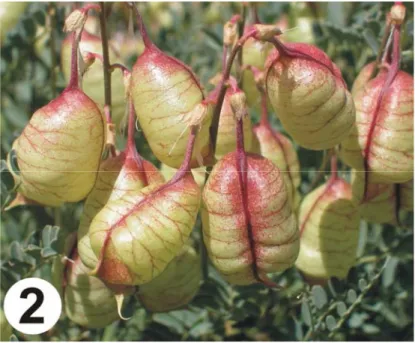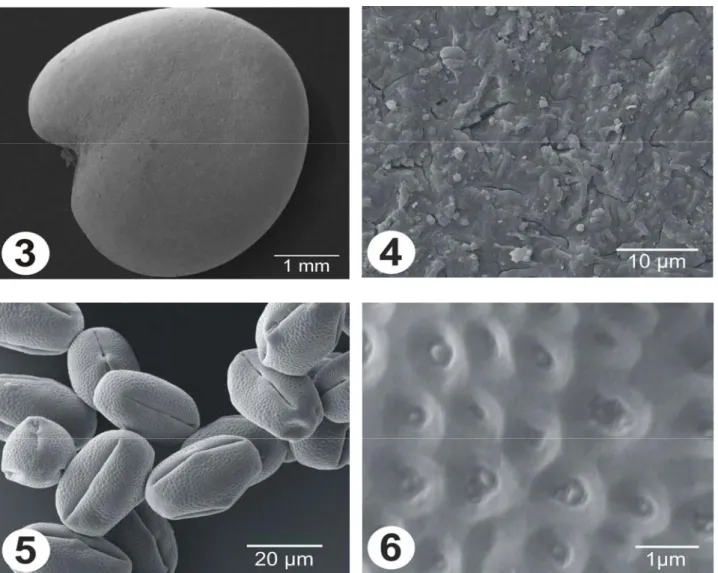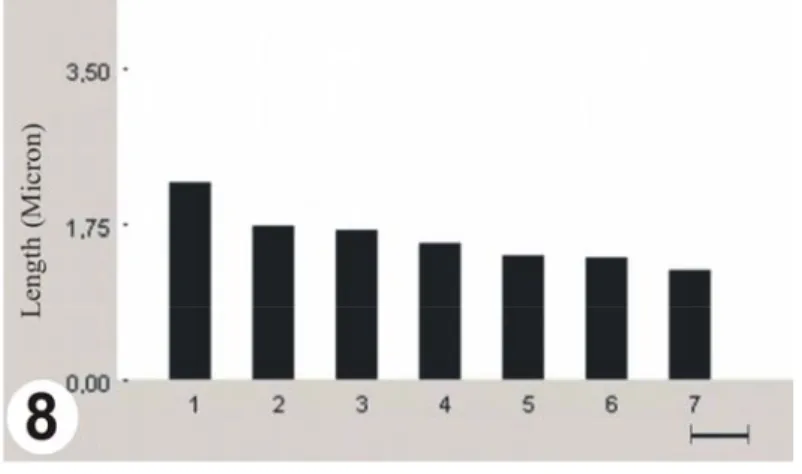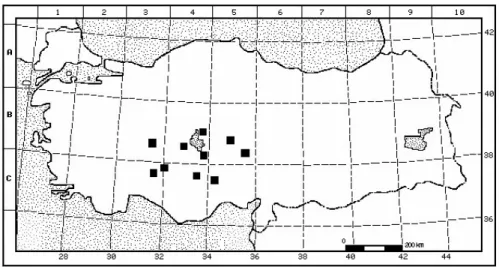www.biodicon.com Biological Diversity and Conservation
ISSN 1308-8084 Online; ISSN 1308-5301 Print 3/2 (2010) 163-169
Morphological, karyological and ecological features of halophytic endemic Sphaerophysa kotschyana Boiss. (Fabaceae) in Turkey
Ahmet DURAN 1, Esra MARTĐN * 2, Meryem ÖZTÜRK1, Özlem ÇETĐN 1,Muhittin DĐNÇ 1, Ayşe ÖZDEMĐR 1 1Selcuk University, Education Faculty of Ahmet Kelesoglu, Department of Biology, 42090, Konya, Turkey
2Nigde University, Faculty of Science and Arts, Department of Biology, 51350, Nigde, Turkey Abstract
Morphological, karyological and ecological features of halophytic endemic Sphaerophysa kotschyana are investigated based on the specimens collected from Tuz Lake environs. The expanded morphological description and illustration of this species is given. This study shows that the somatic chromosome number is 2n=14+0-2B. The pollen grains are prolate, 3-zonocolporate, medium in size, with suprareticulate ornamentation according to the results of SEM studies. Seeds are reniform, the sizes range between 3.5 mm and 4.0 mm in length and width. The seed surface has irregular granules. The karyogram, ideogram, and SEM photos of the pollen and seed surface are presented. In addition, the habitat of its and accompanied species are given as well.
Key words: Ecology, Karyology, Morphology, Sphaerophysa kotschyana --- ∗ ---
Türkiye’de Halofitik Endemik Sphaerophysa kotschyana Boiss. (Fabaceae)’nın Morfolojik, Karyolojik ve Ekolojik Özellikleri
Özet
Tuz Gölü ve çevresinden toplanmış bir halofitik endemik olan Sphaerophysa kotschyana’nın morfolojik, karyolojik ve ekolojik özellikleri incelenmiştir. Genişletilmiş morfolojik deskripsiyonu ve görüntüleri verilmiştir. Bu çalışmada somatik kromozom sayısının 2n=14+0-2B olduğu görülmüştür. SEM çalışmalarına göre polen taneleri prolate, 3-zonokolpate, orta büyüklükte ve suprareticulate ornemantasyonludur. Tohumlar reniform, ebatları 3.5 mm uzunluğunda ve 4.0 mm genişliktedir. Tohum yüzeyi düzensiz granüllüdür. Karyogram, idiyogram, polen ve tohum yüzeyinin SEM’de çekilmiş görüntüleri sunulmuştur. Bunlara ilave olarak, türün habitatı ve birlikte bulunduğu türler hakkında bilgi verilmiştir.
Anahtar kelimeler: Ekoloji, Karyoloji, Morfoloji, Sphaerophysa kotschyana 1. Introduction
Turkey occurring in warm climate zone is distinguished from many countries situating its environments by the plant diversity. The number of plants distributed in Turkey is nearly those in Europe. The plant taxa in Turkey have reached to 12.000 by recently discovered new taxa. The richness of Turkish Flora is based on geographic, climatic, topographic and edaphic factors. These factors bring about the plant formation diversity and infraspecific variation. Turkey is also one of the richest countries in world with respect to endemism. The number of endemic taxa is more than 3000 and endemism ratio is 34.4% (Erik and Tarıkahya 2004; Avcı 2005; Özhatay et al. 2005).
The genus Sphaerophysa DC. was distributed in Middle and Central Asia, from South Siberia to North China, West Caucasia and Anatolia. This genus is represented two species in the world. These are Sphaerophysa kotschyana
*Corresponding author / Haberleşmeden sorumlu yazar: esramartin@gmail.com
Boiss. and S. salsula DC. (Polhill and Raven 1981). The first of these, S. salsula, grows in Iran, Russia, Azerbaijan and Syria, while S. kotschyana is endemic to Central Anatolia (Aytaç and Ekim 1996). According the Bern Convention, S. kotschyana is in under absolute preservation plant list (CITES 2008). There are a few studies on the genus Sphaerophysa as (Chamberlain 1970; Shiskin 1971; Aytaç and Ekim 1996).
True halophytes are plants that able to live under elevated salinities, but also vary in their salt content from slight to brackish to medium to severe to above seawater salinity. In general 2.500-3.000 species of halophytes are found in the world. Nearly 700 species are distributed in the Mediterranean climatic zone (Güvensen et al. 2006).
The ecosystem of which occur in the Tuz Lake and its surrounding is one of the halophyte steppe habitat and watering area where rarely important biological richness of Turkey has accommodate. Both in the South and in the Southwestern part of the Tuz Lake, there exists exceptional area that includes salty and fresh water marsh. There are 35 local endemic plants species which grows especially around Tuz Lake and its surrounding. In Central Anatolia vegetation are dry in summer season except for some perennial and halophyte plants. Most of the halophyte plants are C4 plants and their photosynthesis and growing is very fast. Halophyte plants can adapt to living and maintain growing up in the hardest ecological conditions such as: hot and cold weathers, drought, dryness, saltiness, mineral deficiency and high radiation. The halophyte plants that growing around the Tuz Lake basin shows considerable variation depends on the salt density of the soil. The variation of the edaphic features that the populations of different plants cause to be organized and the population confined like isobaric lines on a map. An observation from far away, halophyte and xerophyte zone plants can easily distinguish the higher areas around the Tuz Lake.
Sphaerophysa kotschyana is closely related to S. salsula. It mainly differs from S. salsula because it has stipules 2-9 mm long (not c. 2 mm), calyx 5-7 mm long (not 4-5 mm), corolla purplish-pink to violet (not red), ovary glabrous (not short appressed hairs, seeds 3.5-4 mm long (not c. 1.5 mm) (Davis 1970; Shiskin 1971).
In this study, S. kotschyana which naturally grows in surrounding of the Tuz Lake were investigated as morphological description, ecological features, pollen and seed micromorphologies and karyology.
2. Materials and methods
Plant samples were collected from Tuz Lake environs. The specimens are dried according to standard herbarium techniques and stored at Selcuk University Education Faculty Herbarium. The collecting locality of the species as follows; morphology and pollen; B4 Konya: Tuz Lake, between Gölyazı-Tersakan, 945 m, 27.05. 2006, roadsides, field margins, 38º35.821'N, 33º07.170'E, A.Duran 7149 (S.Ü. Education Fac. Herb.); morphology; Konya: Cihanbeyli, between Gölyazı-Tuz Lake, c. 15. km, 922 m, 12.06.2006, 38º32.389'N, 33º20.418'E, salt steppe, A.Duran, observation; morphology, seed and karyology; Aksaray: Eskil, 930 m, 30.04.2006, 38º24.319'N, 33º24.543'E, A.Duran 7135 (S.Ü. Education Fac. Herb.); morphology; Ankara: Sereflikoçhisar, Kaldırım Tuzlası, 910 m, 27.05.2006, salt steppe, A.Duran, observation.
These specimens are used for morphological and palynological studies. For the morphological studies, at least ten specimens are investigated, and morphological description of the species was expanded. Palynological investigations are made by both light microscope and scanning electron microscope. For light microscope studies, the pollen slides were prepared according to the Wodehouse technique (Woodehouse 1935). Pollen grains are dissected from herbarium specimens and placed on a clean microscope slides. Glycerin-gelatin with basic fuchsine was placed on pollen and allowed to melt and mixed by a clean pin to get scattered pollen grains. All measurements are determined on at least thirty pollen grains. The pollen grains are also directly placed on prepared stubs and covered with gold for SEM studies. Photographs are taken with SEM. Pollen terminology follows in literature (Erdtman 1960; Punt et al. 1994).
The seeds are examined and photographed under SEM like the pollen. Mitotic chromosome preparations were prepared from root meristems obtained from germinating seeds. Root tips pretreated for 16 h in α-monobromonaphthalene at 4°C, fixed in 3:1 absolute alcohol-glacial acetic acid, then the root tips were hydrolyzed with 1 N HCl for 3 minutes at 60°C an overnight and stained 2% aceto-orcein for 2h at room temperature. Stained root tips were squashed in a drop of 45% acetic acid and permanent slides were made by mounting in Depex. At least 20 counts from seven to ten individuals were made to verify the observations. We examined slides under Olympus BX–50 Photomicroscope using an oil immersion objective (100X). Photographs were taken with the same microscope. The karyogram and ideogram were prepared with measurements taken on enlarged micrographs of five well spread metaphase plates. Chromosome measurement and karyotype were calculated with Bs200Pro Image Analysis Software. Ideogram of species was arranged in order of decreasing length.
3. Results
3.1. Sphaerophysa kotschyana Boiss. (Figures 1- 2). 3.2. Description
Perennial herbs. Plant 20-30 cm tall, ± erect, ± sparsely adpressed bifurcate hairs. Stems slightly striate, 2-3 mm diam. below, densely branched at base or middle part. Leaves alternate, imparipinnate; leaflets 4-8 paired, cuneate-oblong, apex truncate, 5-15 x 2-6.5 mm. Stipules paired, adnate, triangular-lanceolate, membraneceous at margins, 2-9 x 0.5-3 mm, gradually decreasing in size upwards, sparsely bifurcate hairs. Peduncles quadrangular, 5-11 cm. Inflorescence axillary, raceme, 5-12 flowered. Flowers pedicellate. Pedicels 2-5 mm, bracteates, 1-2 mm. Bracteoles sparsely hairy, 0.5-1 mm. Calyx campanulate, 5-7 mm long, sparsely pubescent especially at mouth outside and inside, teeth subequal, triangular ovate to lanceolate, acute 1.5-2.5 mm long. Corolla generally purplish-pink to violet, 15-20 mm. Standard flabellate, 1.3-1.7 x 1.4-1.6 cm; wings oblanceolate, 1.5-1.6 x 0.45-0.55 cm; carina clawed, 1.4-1.8 cm long; claw 0.9-1.2 cm long, with 1-2 mm long auricles at base; limb narrow, 4-5 mm long. Stamens diadelphous. Ovary glabrous. Ripe fruit strongly inflated, indehiscent, oblong-ellipsoid, membranous with 10-12 mm stipe and curved 6-7 mm long style, conspicuously parallel veined. Veins branched, dark green arising from the sture. Seeds 5-8, asymmetric reniform, 3.5-4 x 3.5-4 mm, ± smooth, dark brown (Stearn 1996).
Figure 1. Habitus of Sphaerophysa kotschyana
3.3. Seed characteristics
The seeds of Sphaerophysa kotschyana are asymmetric reniform, on the average, 3.5-4.0 mm long and wide, with an outgrowth about the middle of the sinus. The seed surface is irregular ornamentation Figures 3-4. Epicuticular wax was observed on the surface layer of the seed coat. In microphotographs, its surface features are randomly granulate to slightly roughened.
Figure 3-6. SEM micrographs of the seed coat surfaces and the pollen grains of Sphaerophysa kotschyana. Seed: (3) general shape, (4) seed coat surface; pollen grains: (5) general view, (6) wall detail
3.4. Pollen morphology
The pollen of Sphaerophysa kotschyana are monad, medium sized, 3-zonocolporate. Polar axis (P) is between 27-30 µ m, equatorial axis (E) 16-19 µ m and P/E ratio 1.52-1.66. In the equatorial view, the shape of pollen grain is prolate. The pollen is triangular-obtuse-convex to circular in polar view. The exine thickness is between 1.30-1.45 µm. The exine ornamentation is suprareticulate Figures 5-6.
3.5. Karyological features
The chromosome number and morphology of Sphaerophysa kotschyana has been studied for the first time. The somatic chromosome number of the species was determined to be 2n=14+0-2B (Figure 7). The basic chromosome number for this species is x=7. The total chromosome length is between 1.33-2.22 µm. The total length of the haploid set is 11.83 µm. In addition to somatic number, homologous chromosome pairs were also determined through total length of each chromosome for each slide. However, it was impossible to determine the position of centromers and karyotype formula, because the chromosomes of this species invariable very small. The ideogram and karyogram are
Figure 7. Metaphase chromosomes of Sphaerophysa kotschyana Bar: 5 µm.
Figure 8. Ideogram of Sphaerophysa kotschyana
Figure 9. Karyogram of Sphaerophysa kotschyana 3.6. Ecology
Sphaerophysa kotschyana an endemic species of Turkey and Irano-Turanian element. It grows on salty marsh and salty steppe in mainly Central Anatolia. The species found growing with S. kotschyana include Frankeria hirsuta L., Leymus cappadocicus (Boiss. & Bal.) Melderis, Halimione portulacoides (L.) Allen, Panderia pilosa Fisch. & C.A.Mey., Camphorosma monspeliaca L., Ferula halophila Peşmen, Achillea wilhemsi C.Koch., Centaurea drabifolia Sm., Limonium iconicum (Boiss. & Heldr.) O.Kuntze, Limonium anatolicum Hedge, Astragalus ovalis Boiss. & Bal., Anthemis fumariifolia Boiss., Scorzonera hieraciifolia Hayek, Centaurea bornmulleri Hausskn. ex Bornm., Aeluropus littoralis (Gouan) Parl., Prangos meliocarpoides Boiss. The geographical distribution map of Sphaerophysa kotschyana is given Fig. 10.
Figure 10. The geographical distribution map of Sphaerophysa kotschyana 3.7. Status
The Sphaerophysa kotschyana species placed in VU (Vulnerable) status (Ekim et al. 1989). Nevertheless, the places where it grows are small areas of 100 m2 or less. The great majority of such areas are in use as agricultural land. It seems that S. kotschyana is adapted in such areas. For these reasons, it would be correct to change the status of the plant Vulnerable to the” lower risk near threatened (Lrnt) category of IUCN (IUCN 1994; Aytaç and Ekim 1996). Now, It should be graded as Near Threatened (NT) (IUCN, 2001), because of its local distribution and rather a small population size.
3.8. Economic use
In Turkey the great majority of members of the family Fabaceae are used as animal fodder. But there is no record of Sphaerophysa kotschyana used (Aytaç and Ekim 1996). The S. salsula is one of the widely cultivated plants in U.S.A. This species is using as a medical plant and erosion control. Roots are used for the preparation of medicaments used in gynaecology (Hanelt 2001).
4. Discussion
Sphaerophysa kotschyana, known in the Flora of Turkey from only one locality, has now been represented from ten separate and widely-scattered areas. The following are the collection sites: Afyon, Sultandağı; Ankara, Şereflikoçhisar; Kayseri, Everek; Kayseri, Develi; Denizli, Çardak; Afyon, Dazkırı; Konya, Aslım marhes; Konya, Ereğli; Konya, Cihanbeyli; Aksaray, Eskil. The geographical distribution of the S. kotschyana is mapped (Fig. 10). S. kotschyana grows in salt marshes, salt steppe, and in fields which are within such areas (Aytaç and Ekim 1996).
Sphaerophysa kotschyana was introduced to science world by Edmond Boissier in 1872 (Chamberlain 1970). But the description of this species is very insufficient. Its description was emended with field observation and herbarium materials. But also seed morphology features and mature fruit, seed characteristics which were unknown in Flora of Turkey are described in the present study. Ripe fruits are strongly inflated, oblong-ellipsoid, membranous, with 10-12 mm stipe and curved, with 6-7 mm style, with conspicuously parallel veined. The veins are branched and dark green. Seeds number are 5-8, asymmetric reniform, 3.5-4 x 3.5-4 mm, ± smooth and dark brown.
The seeds and pollen of S. kotschyana are examined by SEM, and its seed surface has irregular ornamentation. The pollen characteristics are monad, 3-zonocolpate, and the shape of pollen grain is prolate and the exine ornamentation is suprareticulate.
The somatic chromosome number of S. kotschyana was determined to be 2n=14+0-2B. The basic chromosome number for this species is x=7. The total chromosome length is between 1.33-2.22 µm. The total length of the haploid set is 11.83 µm. The morphological characters of the genus Sphaerophysa are similar with the genus Colutea L. The diploid chromosome number of Colutea was reported 2n=16, the basic chromosome number for this species is x=8 (Slade 1953). The diploid chromosome number of S. kotschyana 2n=14+0-2B, the basic chromosome number for this species is x=7 and differentiated from the genus Colutea.
In this scope of study, we discussed the ecological properties of Sphaerophysa kotschyana that are naturally grown in the Tuz Lake basin. Besides, in this study determined the karyological properties and the micromorphologies
References
Avcı, M. 2005. Çeşitlilik ve endemizm açısından Türkiye’nin Bitki Örtüsü. Đstanbul Üniversitesi, Edebiyat Fakültesi, Coğrafya Bölümü, Coğrafya Dergisi. 13: 27-55.
Aytaç, Z., Ekim T. 1996. Sphaerophysa kotschyana Boiss. The Karaca Arboretum Magazine. 3: 89-94.
Chamberlain, DF. 1970. Sphaerophysa in: Davis (Ed.) The Flora of Turkey and the East Aegean Islands. Volume III, Edinburgh University Press, Edinburgh.
CITES. 2008. Convention on International Trade in Endangered Species of Wild Fauna and Flora. Appendices I, II and III.
Davis, PH. 1970. Flora of Turkey and East Aegean Island. Volume III, Edinburgh University Press, Edinburgh.
Ekim, T., Koyuncu, M., Erik S., Đlarslan, R. 1989. Türkiye’nin Tehlike Altındaki Nadir ve Endemik Bitki Türleri. Türkiye Tabiatını Koruma Derneği series. 18, Ankara.
Erdtman, G. 1960. The acetolysis method, a revised description. Svensk. Bot. Tidskr. 54: 561-564. Erik, S., Tarıkahya, B. 2004. Türkiye Florası üzerine. Kebikeç. 17: 139-163.
Güvensen, A., Görk, G., Öztürk, M. 2006. An overview of the halophytes in Turkey, in: Ajman Khan, M (Eds). Sabkha Ecosystems. Volume II, West and Central Asia. Springer. 9-30.
Hanelt, P. (Eds). 2001. Mansfeld’s Encyclopedia of Agricultural and Horticultural Crops, Institute of Plant Genetics and Crop Plant Research. Springer.
IUCN Species Survival Commission. 1994. IUCN Red List Categories. Switzerland. IUCN Species Survival Commission. 2001. IUCN Red List Categories. Switzerland.
Polhill, R., Raven, P. (Eds.) 1981. Advances in Legume Systematics. Part I. Royal Bot. Gardens. Kew.
Punt, W., Blackmore, S., Le Thomas, A. 1994. Glossary of Pollen and Spores Terminology. Utrecht, LPP Foundation. Shiskin, BK. (Ed.) 1971. Flora of the U.S.S.R. Israel program for scientific translations. Jerusalem. 11: 235.
Slade, BF. 1953. Somatic chromosome number of the New Zealand broom genera and a discussion of their relationship. Transactions of the Royal Society of New Zealand. 81/1: 1-9.
Stearn, W. 1996. Botanical Latin, 4 th ed. Timber Press, Portland.
Özhatay, N., Byfield, A., Atay, S. 2005. Türkiye’nin 122 önemli bitki alanı. WWF Türk, (Doğal Hayatı Koruma Vakfı) yayını. Đstanbul.
Woodehouse, RP. 1935. Pollen Grains. New York and London.



